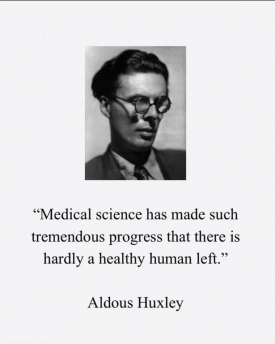Installeer de app
How to install the app on iOS
Follow along with the video below to see how to install our site as a web app on your home screen.
Opmerking: This feature may not be available in some browsers.
Je gebruikt een verouderde webbrowser. Het kan mogelijk deze of andere websites niet correct weergeven.
Het is raadzaam om je webbrowser te upgraden of een browser zoals Microsoft Edge of Google Chrome te gebruiken.
Het is raadzaam om je webbrowser te upgraden of een browser zoals Microsoft Edge of Google Chrome te gebruiken.
Gezondheid
- Onderwerp starter joje
- Startdatum
Having worked in the healthcare industry - on the holistic side - for over 12+ years
I am also qualified to inform you of the following truth:
Anyone asking or requiring you to pay for “packages” or “care up front” is not going to end up helping you resolve your condition
The ONLY reason - and I mean ONLY - they charge you up front like that is because THEY KNOW you will get frustrated when their treatment doesn’t resolve the issue and you will leave - so they’re collecting on it ahead of time.
There is No Other Reason.
Any doctor worth their salt will charge you per visit / tx bc they don’t need marketing tricks / gimmicks / to sell you a bill of goods in order to get your business.
All these holistic doctors charging you upfront are just as much in it for the money and not for your health as the medical system.
Mike
I am also qualified to inform you of the following truth:
Anyone asking or requiring you to pay for “packages” or “care up front” is not going to end up helping you resolve your condition
The ONLY reason - and I mean ONLY - they charge you up front like that is because THEY KNOW you will get frustrated when their treatment doesn’t resolve the issue and you will leave - so they’re collecting on it ahead of time.
There is No Other Reason.
Any doctor worth their salt will charge you per visit / tx bc they don’t need marketing tricks / gimmicks / to sell you a bill of goods in order to get your business.
All these holistic doctors charging you upfront are just as much in it for the money and not for your health as the medical system.
Mike
Now that I have been Given this information, having experienced it to the fullest of its potential personally as it saved my life, and seen it bat 1.000 for any acquired condition it was tested on -- almost 3,000 people in 3 years.
I am 100% confident in the following statement:
The Medical System has 1,000,000% NO BUSINESS belonging in health and wellness. They are not only DEAD WRONG about their diagnoses and treatments are ineffective, but their options for treatment are flat out CRUEL.
Their tactic is Fear.
They offer you ZERO hope.
They do NOT know the cause for ANY chronic illness, conditions, injury, disease, etc.
They have NO cures.
NOT EVEN ONE.
They'll save your life (maybe) in an emergency, and patch you up if you blow your arm off, but that is about it.
Their claim to be the authority on healthcare needs to come to an END.
Here is the 100% absolute Truth:
>Your Body is electrical
>It has electrical cables no different than the ones you use to charge your devices.
>Your brain is super computer with an Operating System infinitesimally more complex than the smartest computer on earth today.
> In fact, computers and electrical components are MODELED AFTER US (not the other way around).
>You are made of minerals
>Minerals that are elements with protons and electrons making them ELECTRIC
>Chemistry Is more aptly called Elemental Electricity
>Those elements form molecules that make up our cells and tissues. They are also our FOOD.
>Your. Electrical. System. Governs. The. Whole. Thing.
>And HEALS ITSELF (you already know this is true)
WHEN you have disease, dysfunction, illness, AND IT DOES NOT RECOVER, it is because your electrical systems are compromised. Period.
Restore them, and you WILL HEAL. Period.
Read it for yourself. Link in Next Post Below
Disease is not something you caught and need to defeat
Disease is when your body’s self healing abilities are compromised
Self healing comes from:
1. Your Electrical Systems
2. DNA
3. Nutrients
4. Immune function
5. Inflammation
Healing causes symptoms so that your conscious mind is aware of it.
They named these symptoms the disease and convinced you all to turn them off.
THAT IS WHY THEY OFFER YOU NO CURE
Their whole basis is to (knowingly or unknowingly) LIE to you about what is happening to you , and what they can do about it.
Healthcare today is one giant FRAUD
And most doctors are the most brainwashed people there are today.
They have been taught that they’re the authority on health but most lay people know more about health than they do.
Not sure what’s worse-
The fact that:
>they don’t know a thing
>they think they do and tell everyone they do
or
>people believe them …..
Mike
I am 100% confident in the following statement:
The Medical System has 1,000,000% NO BUSINESS belonging in health and wellness. They are not only DEAD WRONG about their diagnoses and treatments are ineffective, but their options for treatment are flat out CRUEL.
Their tactic is Fear.
They offer you ZERO hope.
They do NOT know the cause for ANY chronic illness, conditions, injury, disease, etc.
They have NO cures.
NOT EVEN ONE.
They'll save your life (maybe) in an emergency, and patch you up if you blow your arm off, but that is about it.
Their claim to be the authority on healthcare needs to come to an END.
Here is the 100% absolute Truth:
>Your Body is electrical
>It has electrical cables no different than the ones you use to charge your devices.
>Your brain is super computer with an Operating System infinitesimally more complex than the smartest computer on earth today.
> In fact, computers and electrical components are MODELED AFTER US (not the other way around).
>You are made of minerals
>Minerals that are elements with protons and electrons making them ELECTRIC
>Chemistry Is more aptly called Elemental Electricity
>Those elements form molecules that make up our cells and tissues. They are also our FOOD.
>Your. Electrical. System. Governs. The. Whole. Thing.
>And HEALS ITSELF (you already know this is true)
WHEN you have disease, dysfunction, illness, AND IT DOES NOT RECOVER, it is because your electrical systems are compromised. Period.
Restore them, and you WILL HEAL. Period.
Read it for yourself. Link in Next Post Below
Disease is not something you caught and need to defeat
Disease is when your body’s self healing abilities are compromised
Self healing comes from:
1. Your Electrical Systems
2. DNA
3. Nutrients
4. Immune function
5. Inflammation
Healing causes symptoms so that your conscious mind is aware of it.
They named these symptoms the disease and convinced you all to turn them off.
THAT IS WHY THEY OFFER YOU NO CURE
Their whole basis is to (knowingly or unknowingly) LIE to you about what is happening to you , and what they can do about it.
Healthcare today is one giant FRAUD
And most doctors are the most brainwashed people there are today.
They have been taught that they’re the authority on health but most lay people know more about health than they do.
Not sure what’s worse-
The fact that:
>they don’t know a thing
>they think they do and tell everyone they do
or
>people believe them …..
Mike
Mike
Medical doctors (and others in healthcare) are great at ordering the most expensive and intrusive tests that can find you all kinds of details, or none at all, to tell you things that you already know, and just saying and diagnosing it in a different language (greek and latin) to make them sound more important and authoritative than they really are.
My whole question is, once they make you spend hundreds, and many times thousands, on all these tests, what are they going to actually DO with the information?
They LOVE to do all these tests and then say to you:
1. We can't find anything wrong; you're normal
2. We don't know the cause of that, here take this pill
3. We can only help you manage symptoms
4. There is no cure for what you have
Mike
My whole question is, once they make you spend hundreds, and many times thousands, on all these tests, what are they going to actually DO with the information?
They LOVE to do all these tests and then say to you:
1. We can't find anything wrong; you're normal
2. We don't know the cause of that, here take this pill
3. We can only help you manage symptoms
4. There is no cure for what you have
Mike
hilde
Well-known member
wat heerlijk, die mensen die er als de kippen bei zein om er iets vroleiks van te maken
This is a VERY IMPORTANT POST.
Do you understand why?
We have never BEEN MEDICINE/TREATMENT DEFICIENT.
Never Ever.
NEVER EVER EVER.
We are NUTRIENT DEFICIENT and our entire medical profession is predicated on Big Pharma & Treating the maladies & chronic diseases the FDA HAVE SET US UP to suffer.
Raw Milk BANNED!
REAL FOOD replaced with processed SH*T
Seed Oils & Refined Sugars! (Replacing Beef Tallow & Lard because they were unhealthy or too expensive was NOT TRUE)
Now mRNA in our meat products to ALTER our DNA (Our Creator's Gift to you)
They WANT you POOR, SICK, CRAZY & AFRAID.
#SoulWAR #Ascension
Mike
Do you understand why?
We have never BEEN MEDICINE/TREATMENT DEFICIENT.
Never Ever.
NEVER EVER EVER.
We are NUTRIENT DEFICIENT and our entire medical profession is predicated on Big Pharma & Treating the maladies & chronic diseases the FDA HAVE SET US UP to suffer.
Raw Milk BANNED!
REAL FOOD replaced with processed SH*T
Seed Oils & Refined Sugars! (Replacing Beef Tallow & Lard because they were unhealthy or too expensive was NOT TRUE)
Now mRNA in our meat products to ALTER our DNA (Our Creator's Gift to you)
They WANT you POOR, SICK, CRAZY & AFRAID.
#SoulWAR #Ascension
Mike
Dit MOET je zien! Helaas wordt deze tweet van Dr C, waarin een GENEZEN ex-Parkinson patient te zien is, door X gecensureerd. Ik heb daarom na https:// expres een spatie opengelaten. Knip en plak de link en verwijder zelf de spatie.
https:// x.com/OG_DrC/status/1915806056271544717?t=hQrTXabEylTc8IcF-GZjZw&s=19
Mike
https:// x.com/OG_DrC/status/1915806056271544717?t=hQrTXabEylTc8IcF-GZjZw&s=19
Mike
Godsgeschenk
Well-known member
Volgende bericht verschijnt:Dit MOET je zien! Helaas wordt deze tweet van Dr C, waarin een GENEZEN ex-Parkinson patient te zien is, door X gecensureerd. Ik heb daarom na https:// expres een spatie opengelaten. Knip en plak de link en verwijder zelf de spatie.
https:// x.com/OG_DrC/status/1915806056271544717?t=hQrTXabEylTc8IcF-GZjZw&s=19
Mike
Hm ... deze pagina bestaat niet. Zoek iets anders.
Dorothé
Zoals gezegd, na :// de spatie weghalen.
Mike
Mike
Zo beter?
Mike
Mike
Godsgeschenk
Well-known member
Zo beter?
Mike
Dank je. Ja, ik had de spatie weggehaald en dat leverde niets op. Dus ik ben blij met bovenstaand bericht.
Dorothé
Medical Terminology: The Hidden Language of Control and How to Reclaim Your Health
Introduction
If you are reading this, you are about to discover something that will forever change the way you view "medicine," "disease," and "health."
Modern healthcare, built over centuries, has developed an impressive arsenal of technical terms—mostly borrowed from Greek, Latin, and the surnames of "medical authorities."
But here's the truth: the complexity is not for your benefit. It’s there to obscure the simple, self-evident reality of the body's innate, perfect design to heal and regenerate itself. It creates a gap—a linguistic barrier—that keeps you dependent, fearful, and disempowered.
Sometimes, the symptoms and effects you experience are not signs of failure at all—they are the result of the body's intelligent hierarchy at work. The body is willing to sacrifice less vital tissues and structures to protect the essential control centers of life at the brainstem and core organs. Just as in frostbite, where the fingers and toes are sacrificed to preserve blood flow to the heart and brain, your body makes conscious choices in a crisis, redirecting resources, shutting down non-essential areas, and triggering pain not as punishment, but as information.
It is important to recognize that much of this prioritization is directed by the state of the autonomic nervous system—the subconscious division of your electrical system that governs critical life functions. When dysfunction occurs at the brainstem, often from upper cervical misalignment, the body's communication system can become locked inappropriately into either the sympathetic (fight or flight) mode or the parasympathetic (rest and digest) mode.
However, it is not only autonomic function that suffers. All nerves—carrying both sensory and motor signals—must travel through this delicate junction. When the brainstem is under stress or distortion, the entire electrical system of the body becomes vulnerable to miscommunication. This can result in:
Hypersignaling, where tissues and organs are overstimulated, leading to spasm, inflammation, and pain.
Hyposignaling, where tissues are understimulated, leading to weakness, degeneration, and eventual failure.
In reality, most dysfunction is not purely one or the other, but varying degrees of both across different regions.
Being stuck in either a hyper or hypo signaling state leads to widespread, systemic dysfunction. The nervous system continues to operate exactly as the DNA programming instructs, but if the signals themselves are corrupted, the outcomes—though "logical" to the system—become destructive to the organism.
Symptoms like pain, inflammation, swelling, stiffness, and even weakness are not always signs of something "wrong"; they are often signs of the body's attempts to heal, repair, and stabilize. Pain especially is misunderstood: it is a communication signal, not a disease. Sometimes it warns of injury. Sometimes it marks the progress of repair. Dangerously, a total absence of pain when it should be present can be even worse—indicating a failure of communication altogether, silently allowing further damage.
This article will show you how medical terminology was engineered, why it sounds terrifying, how it hides common natural processes, and most importantly, how to reclaim your understanding.
READ:

 drchw17.substack.com
drchw17.substack.com









 drchw17.substack.com
drchw17.substack.com
Mike
Introduction
If you are reading this, you are about to discover something that will forever change the way you view "medicine," "disease," and "health."
Modern healthcare, built over centuries, has developed an impressive arsenal of technical terms—mostly borrowed from Greek, Latin, and the surnames of "medical authorities."
But here's the truth: the complexity is not for your benefit. It’s there to obscure the simple, self-evident reality of the body's innate, perfect design to heal and regenerate itself. It creates a gap—a linguistic barrier—that keeps you dependent, fearful, and disempowered.
Sometimes, the symptoms and effects you experience are not signs of failure at all—they are the result of the body's intelligent hierarchy at work. The body is willing to sacrifice less vital tissues and structures to protect the essential control centers of life at the brainstem and core organs. Just as in frostbite, where the fingers and toes are sacrificed to preserve blood flow to the heart and brain, your body makes conscious choices in a crisis, redirecting resources, shutting down non-essential areas, and triggering pain not as punishment, but as information.
It is important to recognize that much of this prioritization is directed by the state of the autonomic nervous system—the subconscious division of your electrical system that governs critical life functions. When dysfunction occurs at the brainstem, often from upper cervical misalignment, the body's communication system can become locked inappropriately into either the sympathetic (fight or flight) mode or the parasympathetic (rest and digest) mode.
However, it is not only autonomic function that suffers. All nerves—carrying both sensory and motor signals—must travel through this delicate junction. When the brainstem is under stress or distortion, the entire electrical system of the body becomes vulnerable to miscommunication. This can result in:
Hypersignaling, where tissues and organs are overstimulated, leading to spasm, inflammation, and pain.
Hyposignaling, where tissues are understimulated, leading to weakness, degeneration, and eventual failure.
In reality, most dysfunction is not purely one or the other, but varying degrees of both across different regions.
Being stuck in either a hyper or hypo signaling state leads to widespread, systemic dysfunction. The nervous system continues to operate exactly as the DNA programming instructs, but if the signals themselves are corrupted, the outcomes—though "logical" to the system—become destructive to the organism.
Symptoms like pain, inflammation, swelling, stiffness, and even weakness are not always signs of something "wrong"; they are often signs of the body's attempts to heal, repair, and stabilize. Pain especially is misunderstood: it is a communication signal, not a disease. Sometimes it warns of injury. Sometimes it marks the progress of repair. Dangerously, a total absence of pain when it should be present can be even worse—indicating a failure of communication altogether, silently allowing further damage.
This article will show you how medical terminology was engineered, why it sounds terrifying, how it hides common natural processes, and most importantly, how to reclaim your understanding.
READ:

Exposing Medical Terminology
Medical Terminology: The Hidden Language of Control and How to Reclaim Your Health

Exposing Medical Terminology
Medical Terminology: The Hidden Language of Control and How to Reclaim Your Health
Mike
Are you able to control the beat of your heart
Are you able to control the breath of your lungs
Are you able to control how you digest nutrients
Are you able to control the color of your skin , hair, or eyes
Are you able to with your own might control any part of you aside from conscious motor operations
……
What makes you think you control your healing ?
What makes you think there is anything you can do to regenerate yourself - or anyone else ?
Billions upon billions of Individual cells beat harmoniously to the drum of your built in electricity
When you realize all you have to do is turn the Light back on - all that you have attempted to do for yourself will manifest without any effort on your part.
All you have to do is live
Let the truth set those with eyes to see and ears to hear FREE
De gecensureerde tweet vind je onder deze post.
Mike
Are you able to control the breath of your lungs
Are you able to control how you digest nutrients
Are you able to control the color of your skin , hair, or eyes
Are you able to with your own might control any part of you aside from conscious motor operations
……
What makes you think you control your healing ?
What makes you think there is anything you can do to regenerate yourself - or anyone else ?
Billions upon billions of Individual cells beat harmoniously to the drum of your built in electricity
When you realize all you have to do is turn the Light back on - all that you have attempted to do for yourself will manifest without any effort on your part.
All you have to do is live
Let the truth set those with eyes to see and ears to hear FREE
De gecensureerde tweet vind je onder deze post.
Mike
Forum statistieken









